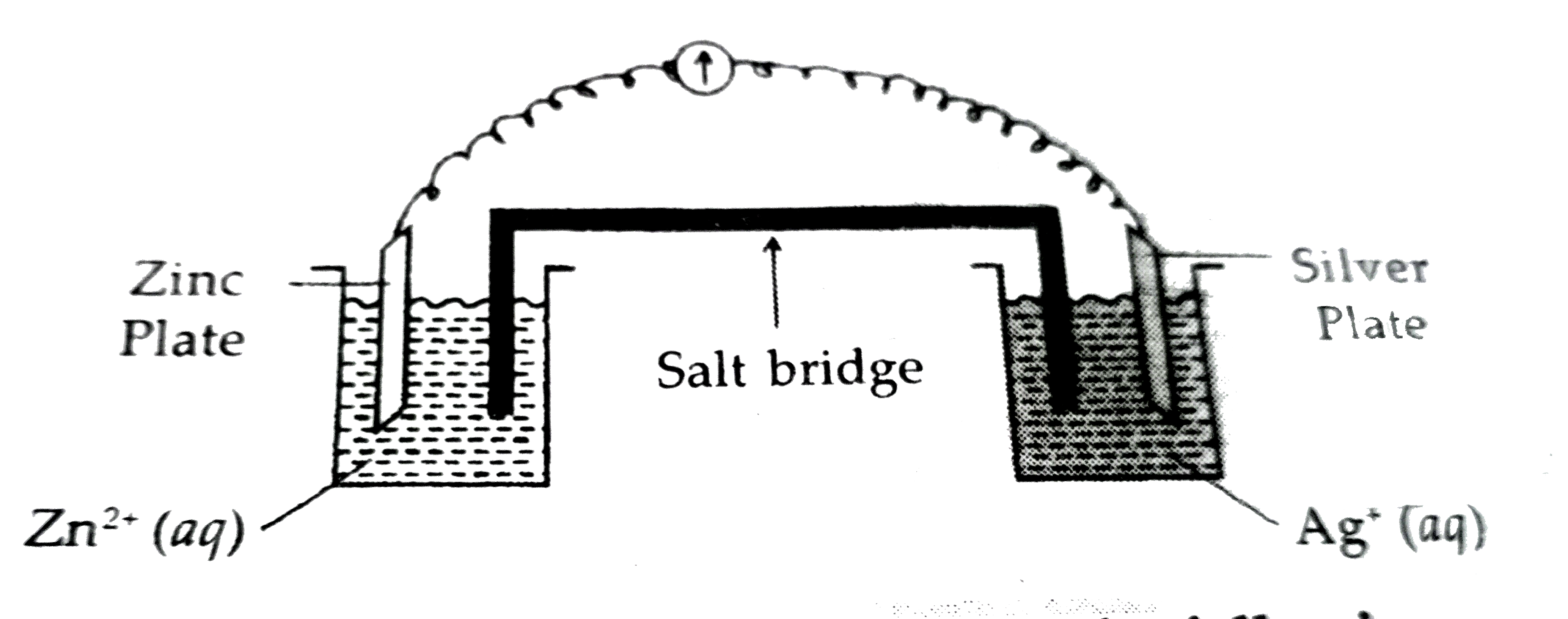250 mL of a waste solution obtained from the workshop of a goldsmith contains 0.1MAgNO3 and 0.1MAuCl. The solution was electrolyzed at 2 V by passing a current of 1 A for 15 minutes. The metal/metals electrodeposited will be :
(E∘Ag+/Ag=0.80V,E∘Au+/Au=1.69V)
silver and gold in equal mass proportion
only gold
only silver
silver and gold in proportion to their atomic weights
To solve the problem, we need to determine which metal, silver (Ag) or gold (Au), will be deposited first during the electrolysis of the given solution. We will use the standard reduction potentials provided for both metals.
1. Identify the Given Data:
- Volume of the solution = 250 mL = 0.250 L
- Molarity of AgNO₃ = 0.1 M
- Molarity of AuCl = 0.1 M
- Current (I) = 1 A
- Time (t) = 15 minutes = 15 × 60 = 900 seconds
- Standard reduction potential for Ag⁺/Ag = 0.80 V
- Standard reduction potential for Au⁺/Au = 1.69 V
2. Calculate the Amount of Charge Passed:
Q=I×t=1A×900s=900C
3. Determine the Moles of Electrons Transferred:
Using Faraday's constant (F = 96500 C/mol),
Moles of electrons=QF=900C96500C/mol≈0.00932mol
4. Determine the Moles of Each Metal Ion in Solution:
- Moles of Ag⁺ in 250 mL of 0.1 M solution:
Moles of Ag=0.1mol/L×0.250L=0.025mol
- Moles of Au⁺ in 250 mL of 0.1 M solution:
Moles of Au=0.1mol/L×0.250L=0.025mol
5. Determine the Standard Gibbs Free Energy Change (ΔG) for Each Metal:
The Gibbs free energy change is given by:
ΔG=−nFE
- For Ag:
ΔGAg=−1×96500×0.80=−77200J/mol
- For Au:
ΔGAu=−1×96500×1.69=−163485J/mol
6. Compare the Gibbs Free Energy Changes:
Since ΔGAu is more negative than ΔGAg, gold will be deposited first.
7. Conclusion:
The metal deposited first during the electrolysis will be gold (Au).
- Volume of the solution = 250 mL = 0.250 L
- Molarity of AgNO₃ = 0.1 M
- Molarity of AuCl = 0.1 M
- Current (I) = 1 A
- Time (t) = 15 minutes = 15 × 60 = 900 seconds
- Standard reduction potential for Ag⁺/Ag = 0.80 V
- Standard reduction potential for Au⁺/Au = 1.69 V
Q=I×t=1A×900s=900C
Using Faraday's constant (F = 96500 C/mol),
Moles of electrons=QF=900C96500C/mol≈0.00932mol
- Moles of Ag⁺ in 250 mL of 0.1 M solution:
Moles of Ag=0.1mol/L×0.250L=0.025mol
- Moles of Au⁺ in 250 mL of 0.1 M solution:
Moles of Au=0.1mol/L×0.250L=0.025mol
The Gibbs free energy change is given by:
ΔG=−nFE
- For Ag:
ΔGAg=−1×96500×0.80=−77200J/mol
- For Au:
ΔGAu=−1×96500×1.69=−163485J/mol
Since ΔGAu is more negative than ΔGAg, gold will be deposited first.
The metal deposited first during the electrolysis will be gold (Au).
Topper's Solved these Questions
Similar Questions
100 ml solution of each 0.1 M AuCl and 0.1 AgCl is electrolysed by passing 1 amp current for 15 minutes then which of the following will be deposited?
given Au++e−→AuE∘=1.69V
Ag++e−→AgE∘=0.80V
View SolutionCan a solution of 1 M ZnSO4 be stored in a vessel made of copper ? Given that
E∘Zn+2/Zn=−0.76VandE∘Cu+2/Cu=0.34V
View SolutionWhat must be concentration of Ag+ in an aqueous solution containing Cu2+=1.0M so that bot the metals can be
deposited on the cathode simultaneously. Given that
E0Cu/Cu2+=0.34V and E0Ag+/Ag=0.812V,T=298K
View SolutionA 100.0mL dilute solution of Ag+ is electrolysed for 15.0 minutes with a current of 1.25mA and the silver is removed completely. What was the initial[Ag+]?
View SolutionA copper-silver cell is set up. The copper ion concentration in it is 0.10 M. The concentration of silver ions is not known.The cell potential measured is 0.422 V. Determine the concentration of silver ions in the cell. [Given E∘Ag+/Ag=0.80,E∘Cu2+/Cu=+0.34V]
View SolutionFour different solution containing 1M each of Au+3,Cu+2,Ag+,Li+ are being electrolysed by using inert electrodes. In how many samples, metal ions would be deposited at cathode?
[Given :E0Ag+/Ag=0.8,E0Au+3/Au=1.00V
E0Cu+2/Cu=0.34V,E0Li+/Li=−3.03V]
View Solution(a) When a bright silver object is placed in the solution of gold chloride, it acquires a golden tings but nothing happens when it is placed in solution of copper chloride. Explain this behaviour of silver.
[Given : E∘Cu2+/Cu=+0.34V,E∘Ag+/Ag=+0.80V,E∘Au3+/Au=+1.40V]
(b)
Consider the figure given above and answer the following questions :
(i) What is the direction of flow of electrons?
(ii) Which is anode and which is cathode?
(iii) What will happen if the salt bridge is removed ?
(iv) How will concentration of Zn2+ and Ag+ ions be affected when the cell functions ?
(v) How will concentration of these ions be affected when the cell becomes dead ?
View SolutionAn aqueous solution containing 1M each of Au3+,Cu2+,Ag+,Li+ is being electrolysed by using inert electrodes. The value of standard potentials are :
E∘Ag+/Ag=0.80V,E∘Cu+/Cu=0.34V and E∘Au+3/Au=1.50,E∘Li+/Li=−3.03V
will increasing voltage, the sequence of deposition of metals on the cathode will be :
View SolutionWhen a solution of AgNO3 (1 M) is electrolysed using Pt anode and Cu cathode, the products at two electrodes are?E∘cu2+∣cu=+0.34V,E∘O2,H+∣H2O=+1.23V,E∘ag+∣Ag=+0.8V
View SolutionA volataic cell consists of an electode of solide silver immerse in a 0.10MAgNO3 solution and an electrode of unknown metal 'X' immersed in a 0.10M solution X(NO3)2. A porous barrier separates the two half of the cell. Also given :
Ec−.(Ag⊕∣Ag)=0.80V and Ec−.cell=1.05V at 25∘C
X(s)∣∣X2+(1.0M)∣∣∣∣Ag⊕(0.1M)∣∣Ag(s)
If Ag⊕∣Ag half cell in the above voltaic cell is replaced by Zn2+∣Zn half cell (Ec−.Zn2+∣Zn=−0.76V)
View Solution
